Castillo san cristóbal: Park Components – San Cristobal
Park Components – San Cristobal
The devastating effects of the attacks by the English in 1598 and the Dutch in 1625 forced the Spaniards to expand the fortification system of San Juan. They lengthened the city walls and constructed a sentry box or “garita” (Garita del Diablo) on the coast to the east of El Morro and also a small artillery platform on top of a hill named San Cristóbal. Named after the saint patron of land travelers, Saint Christopher, Castillo San Cristóbal, is considered the largest fortress built in the Americas. It was built for the purpose of protecting the city of San Juan from attack by land from the east. It is a fortification with three levels and an extensive series of outer defenses and it took over 150 years to complete. The Irish born Tomás O’Daly was Chief Engineer and he was assisted by Juan Francisco Mestre. Following the principles of the French-influenced “Vauban-style fortress” (featuring irregular and triangular shaped bastions) and a “Defense in Depth” strategy, San Cristóbal was built with a deep dry moat and a series of tunnels. The main plaza of San Cristóbal was the heart of the fort. It is where troops drilled, were inspected and assembled for formal events. Eleven casemates border the plaza. Casemates are large vaulted, bombproof rooms designed with gun ports for cannon. The arch in the ceiling provided strength to support gun desks above and withstand the concussion of shells exploding overhead. Casemates also housed officers’ quarters, barracks, storage areas, the kitchen and latrine. Thick-walled gunpowder magazines were built close by the plaza, casemates and tunnels and were designed to provide optimal conditions for the storage of the powder. The fort was designed to catch and retain as much rainwater as possible and the 5 cisterns underneath the plaza could hold approximately 800.000 gallons of rain water. These cisterns are in use today for the maintenance of the park and are an excellent example of how we can learn about the self-sufficient practices of centuries ago. Visitors will appreciate some of the additions made by the US Army during World War II. There are two coastal observation posts and a 1942 bunker which serves as our current Visitors’ Center. Castillo de San Cristóbal is massive and imposing; a masterpiece of 18th century military engineering and innovation. Modern military strategists and history buffs enjoy learning of the ingeniousness of its design; all visitors are inspired by the beauty of the architecture and the setting.
|
Last updated: December 26, 2019
Visiting Castillo San Cristobal in San Juan, Puerto Rico (+ Photos and Tips!)
San Juan, Puerto Rico’s capital, is famous for its old fortifications. Castillo San Cristobal is one of San Juan’s two must-visit historic forts from the colonial era. Continue reading for the ultimate guide to visiting Castillo San Cristobal!
Part of San Juan’s National Historic Site and part of a UNESCO World Heritage Site, Castillo San Cristobal is worth visiting for its fascinating history, its military architecture, and stunning views over the city and over the Caribbean Sea.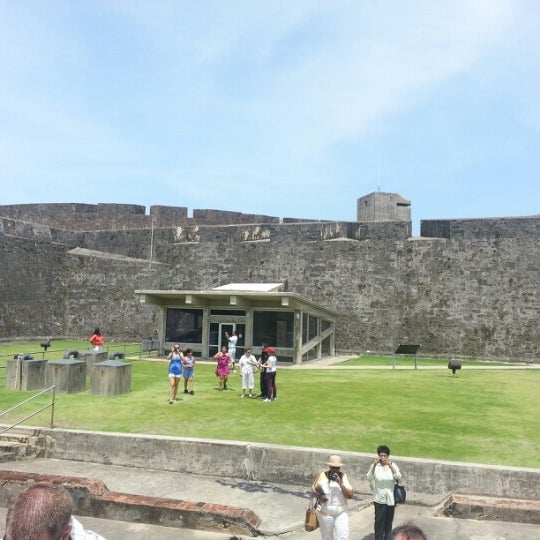
Castillo San Cristobal is a historic fort in Old San Juan
In fact, together with El Morro, San Juan’s other historic fort, exploring Castillo San Cristóbal should be at the top of your list of things to do in Old San Juan.
And don’t forget your camera: you’ll find lots of beautiful photo spots everywhere in the fort.
The History of Castillo San Cristóbal
San Juan was a prize coveted by many European nations during colonial times. Spain built a chain of fortifications to protect the city and harbor from other nations.
While El Morro was built by Spain to protect San Juan against attacks from the sea, Castillo San Cristobal was built to protect it against land-based attacks, after the Dutch attacked and captured San Juan from the land side in 1625.
San Juan was coveted by many European powers
Covering an area of about 27 acres, Castillo San Cristobal is the largest fort built by the Spanish in the New World.
The fort, which was originally just a redoubt, sits on top of a hill, about 150 feet above sea level.
Castillo San Cristobal is named after Saint Christopher, the patron saint of land travelers.
Walking a terrace at the fort
Although work on the fortification occurred over a period of 150 years, major construction began in 1766 and the fort was completed in 1783.
The completed fort encircled the entire city of San Juan, which remained walled in until the end of the 19th century, when a part of the walls was demolished to allow the city to expand.
The old entrance into the fort
In 1797, British troops (the largest contingent ever to attack a Spanish colony in the New World) attacked San Juan from the land side, and Castillo San Cristobal helped ward them off.
On May 10, 1898, a shot from a cannon at Castillo San Cristobal marked the beginning of the hostilities between the United States of America and Puerto Rico.
With that shot, aimed at a US battleship, Puerto Rico had entered the Spanish-American War, and the two sides spent the rest of the day exchanging fire.
The massively thick walls of Castillo San Cristobal
The Spanish-American War ended with the Treaty of Paris, when Puerto Rico became a US territory.
During World War II, Castillo San Cristobal served as an active US military base, with the addition of an underground bunker that served as a control center.
In 1949, the San Juan National Historic Site, which included Castillo San Cristobal, was established.
In 1961, the US Army turned Castillo San Cristobal over to the US National Park Service, to be preserved and administered as a museum.
Castillo San Cristobal is part of the San Juan National Historic Site
In 1966, the San Juan National Historic Site was added to the National Register of Historic Places, and in 1983, the historic fortifications of San Juan were designated a UNESCO World Heritage Site.
What to see at Castillo San Cristobal
With three levels of fortifications, a deep dry moat on the land side, cisterns to store water, and a system of tunnels, Castillo San Cristobal makes for a fascinating wander if you enjoy military architecture and history.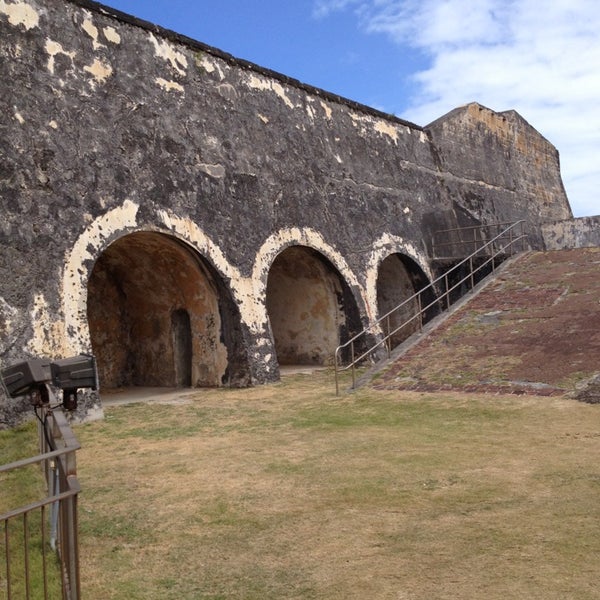
And the views are the icing on the cake!
Looking down into the main plaza of Castillo San Cristobal
If you walk to Castillo San Cristobal via the road along the water, you’ll enter the fort through the side entrance. Pause for a bit to stroll the courtyard outside and take in the views before you go in.
A sentry box just outside Castillo San Cristobal
The main gates into the fort are further along the road. Vehicular traffic can enter the fort via the main entrance.
While both entrances are impressive, the smaller side entrance, which opens out into the main plaza, is much more picturesque.
The picturesque historic entrance into Castillo San Cristobal
The bunker built by the US Army in 1942 is the site of the Visitor Center at the fort, at the lowest level. There’s also a theater here, where you can watch a film about the park.
Once you go to the first floor, you’ll be in the beautiful main courtyard of the fort. This courtyard was where military drills were held.
The covered passageway to the left as you enter has a beautiful Instagram spot with richly colored textured walls and an old wagon.
Covered walkway on the periphery of the main plazaA beautiful spot in the main plaza, perfect for Instagram!This pretty door dresses up the main plaza
Along the periphery of the main courtyard are several rooms featuring ports for cannon.
With thick bombproof walls, the rooms bring home the fact that you are in a formidably strong fortress. They housed living quarters, kitchen, and storage areas. Here also you will find the modest chapel.
The colors of Castillo San Cristobal are gorgeous!The simple chapel in the fort
One of the fascinating aspects of San Cristobal are the five large underground water cisterns, located under the main plaza. The cisterns were built to catch and store rain water, and are still in use, with the water used to maintain the park.
From the main plaza, a long tunnel leads out onto one of the terraces of the fort. As you walk the tunnel, keep your eyes peeled for a little side passage, which used to be a dungeon.
As you walk the tunnel, keep your eyes peeled for a little side passage, which used to be a dungeon.
Here you will find an old drawing of a ship, possibly made by a prisoner a long time ago.
Look for the mural of the ships in the dungeon!
Castillo San Cristobal features six underground passages, called galleries. They were used to keep soldiers protected during attacks, and to safely move soldiers from one part of the fort to another.
Walking through a tunnel at Castillo San Cristobal
From the upper terraces of the fort, enjoy panoramic views over Old San Juan. Beyond, you’ll see the Capitol building, and the highrises of San Juan.
A view of the Puerto Rican Capitol from the Castillo San CristobalA view over the city from the upper terrace of the fort
From the eastern viewpoints, admire the views of the colorful houses of La Perla. Beyond, you will see the Old San Juan Cemetery, and El Morro.
A view of the colorful houses of La Perla and beyond to El Morro
Wander the terraces to appreciate the massively thick walls, and snap photos of the stacks of cannonballs.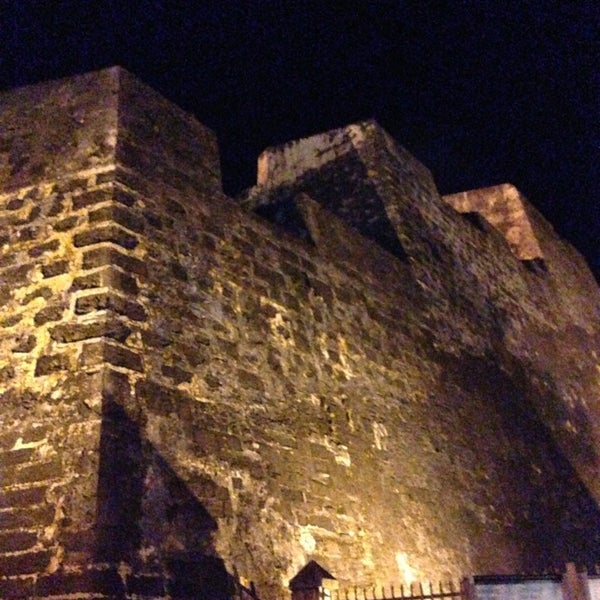 Admire the flags of the USA and Puerto Rico, and the Cross of Burgundy flag, as they flutter in the breeze.
Admire the flags of the USA and Puerto Rico, and the Cross of Burgundy flag, as they flutter in the breeze.
Cannonballs stacked on the terrace of the castillo
The garitas, or sentry boxes, offer fabulous views of the water. You can walk right into one of the boxes and peer out exactly like the sentries did in colonial times. Very cool!
Walking to one of the sentry boxes at the fort
Also, from the eastern viewpoints, you can see La Garita del Diablo, the lone sentry box built down at the water level, jutting out into the sea.
Built in 1634, this sentry box is one of the oldest parts of Castillo San Cristobal.
A view of the historic sentry box that juts out into the sea
There are many information boards and plaques located all around the fort. Take the time to read them: the history of the fort and the city is fascinating.
There is lots of information to study at the fort!
Tips and Information for Visiting Castillo San Cristobal
Exploring Castillo San Cristobal is definitely one of the most fun things to do in Old San Juan. Here is my guide to visiting Castillo San Cristobal, with essential information and tips that will hopefully make your visit enjoyable!
Here is my guide to visiting Castillo San Cristobal, with essential information and tips that will hopefully make your visit enjoyable!
Where is Castillo San Cristobal located?
Castillo San Cristobal is located on Calle Norzagaray in Old San Juan, the historic district in the Puerto Rican capital. It is sited on a hilltop overlooking San Juan Bay.
Getting to Castillo San Cristobal
If you are staying anywhere within Old San Juan, you can walk to Castillo San Cristobal. You can also ride on the Old San Juan Trolley, which is free and drops you right at the entrance to the fort.
From other districts in San Juan, you can drive yourself or take a taxi or an Uber to the fort.
Walking the beautiful waterfront path from El Morro to Castillo San Cristobal
If you arrive by car, park in the parking garage located on Calle Norzagaray, under Plaza del Quinto Centenario. From the parking lot, you can walk to Castillo San Cristobal in about 5 to 10 minutes.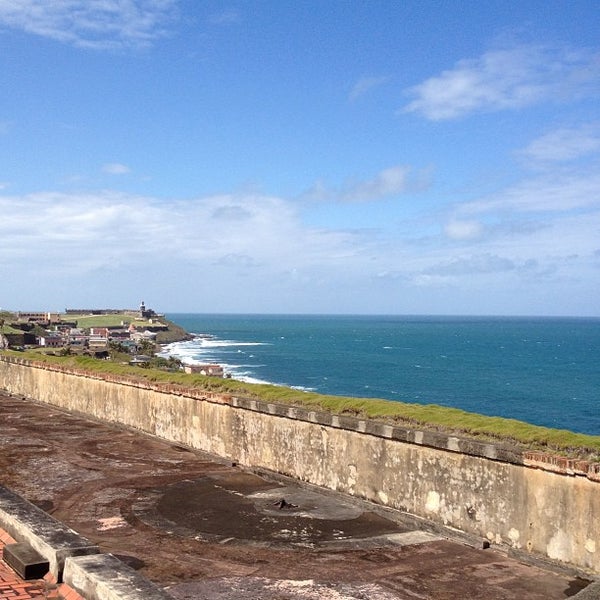
Admission to Castillo San Cristobal
There is a modest admission fee to visit Castillo San Cristobal. At the time of writing, the admission fee for an adult is USD10, and the fee covers both Castillo San Cristobal and El Morro, San Juan’s other historic fort located nearby.
Castillo San Cristobal is a treasured landmark in San Juan!
If you have an America the Beautiful National Parks pass,, it covers admission to both Castillo San Cristobal and El Morro, so remember to take your pass with you when you visit!
Don’t have a pass yet? Buy one online at REI! It’s valid for one year and pays for itself if you plan to visit several parks during the year.
You can buy tickets at the entrance to Castillo San Cristobal on the day of your visit. Pick up a brochure at the entrance desk.
How much time should you allow at Castillo San Cristobal?
Allow at least two hours to explore Castillo San Cristobal.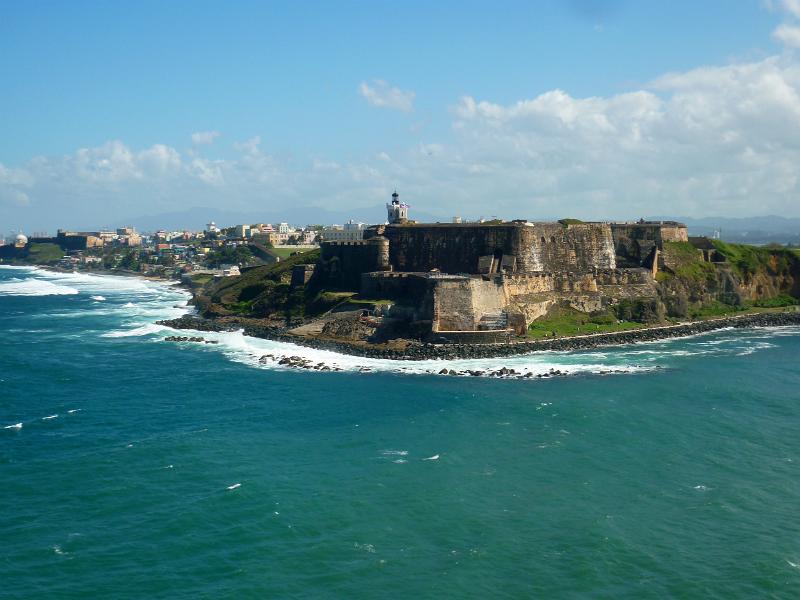 We spent about 3 hours, walking around enjoying the views, and reading all the interesting information boards.
We spent about 3 hours, walking around enjoying the views, and reading all the interesting information boards.
Check about ranger-led tours scheduled for the day you plan to visit, to maximize your time at the fort. If you have more time to spare after the tour, you can wander around some more on your own and take photos.
Accessibility
Castillo San Cristobal is built over three levels, and there are steps, ramps, and narrow passages and tunnels.
Wear comfortable walking shoes. Also carry a windcheater or light jacket: the breeze on the terraces is pretty strong.
An underground passage in the fort
Inside the main entrance, you will find accessible restrooms and water fountains. There is also a bookstore here, and the theater where you can watch the film about the National Historic Site.
From the main entrance, you can take an elevator to the main courtyard on the first floor. Upper levels can only be accessed via steep ramps. The side entrance to the fort, on Calle Norzagaray, is also accessible, but the ramp is fairly steep.
The side entrance to the fort, on Calle Norzagaray, is also accessible, but the ramp is fairly steep.
The best time to visit Castillo San Cristobal
As one of Viejo San Juan’s top attractions, Castillo San Cristobal tends to get crowded during the day, especially if you visit during the peak season (mid December through mid April).
Visit early in the day for fewer crowds in season. We visited El Morro first, at opening time, and had it almost to ourselves.
By the time we arrived at Castillo San Cristobal, there were quite a few other visitors, and we had to wait our turn to enter the sentry boxes for photos.
Park hours
The San Juan National Historic Site, which includes Castillo San Cristobal, is generally open every day from 9 a.m. until 6 p.m., except for Thanksgiving, Christmas, and New Year’s Day.
Amenities at Castillo San Cristobal
Restrooms and water fountains are located on the entrance level and in the main plaza on the first floor. There is a bookstore and gift shop with snacks, drinks, and souvenirs, also located on the main entrance level.
There is a bookstore and gift shop with snacks, drinks, and souvenirs, also located on the main entrance level.
Where to stay in Old San Juan
We stayed in the historic Hotel El Convento. The lovely old hotel is located in the heart of the historic district, convenient walking distance to most sights in the old city, including Castillo San Cristobal.
Rooms are spacious, and furnishings elegant. We felt pampered, with turndown service and an evening reception with quality wine and cheese. You will love the rooftop pool with its beautiful views, and the courtyard restaurant is a happening place come evening.
Book a stay here
*****
So there you have it: my guide to historic Castillo San Cristobal in San Juan, Puerto Rico! Have you visited? I would love to read your thoughts, if you have: comment below to respond!
If you haven’t yet visited, I hope you plan a trip to San Juan soon! And if you are already planning a visit to Puerto Rico, yay! Check out my Puerto Rico itinerary for a memorable first visit to the beautiful Caribbean island!
Also check out our other in-depth guides for other famous sights around the world:
- California: One Day in Balboa Park, San Diego’s Urban Oasis
- Rome: Tips for Visiting the Borghese Gallery
- Bergen: Riding the Floibanen Funicular to the Top of Mt.
 Floyen
Floyen - Stockholm: Visiting Drottningholm Palace on a Day Trip
- Italy: 20 Spectacular UNESCO World Heritage Sites in Italy
- Massachusetts: The Best Things to Do at the Boston Public Garden
- Seville: Visit the Royal Alcazar of Seville!
Did you find this article informative? Pin it for later reference!
Puerto Rico Attractions | Vectorme, Vectorme
San Juan National Historic Site includes the fortifications of Castillo San Cristobal and Castillo San Felipe del Morro. All these defensive fortifications surround the old colonial part of San Juan, Puerto Rico. The Spanish military began building these impressive fortifications in early 1539 with a tower at El Morro and La Fortaleza. These works took more than 250 years. Most of the walls we see today were added later during construction, which lasted from 1760 to 1780. San Juan National Historic Site was designated a World Heritage Site on 1983 year.
El Morro
Officially known as the Castillo San Felipe del Morro, it sits atop a high headland overlooking the entrance to San Juan Bay. This impressive structure is the result of the efforts of many Spanish engineers over 250 years and is one of the largest forts built by the Spanish in the Caribbean, with walls rising to a height of 18 meters, an impressive fact for buildings of that era.
Although the foundations were laid in 1539, the six-storey fort was not considered complete until 1787. During World War II, the US government added an extension of their own design to the top of the fort. This huge structure has been subjected to countless attacks, including against the famous Francis Drake in 1595 ( Francis Drake – English admiral who circumnavigated the world from 1577 to 1580, helped defeat the Spanish Armada in 1588 and was the most famous sailor of the Elizabethan era, including those involved in piracy and the slave trade ) and the Dutch fleet in 1625 year. In 1898, American ships bombarded the fort during the war between the United States and Spain and destroyed its lighthouse, which was later rebuilt. In this defensive structure, as was customary in those days, in addition to the barracks and storehouses of ammunition and provisions, there were living quarters for officers with families and even a prison where you can see pictures of prisoners on the walls.
In 1898, American ships bombarded the fort during the war between the United States and Spain and destroyed its lighthouse, which was later rebuilt. In this defensive structure, as was customary in those days, in addition to the barracks and storehouses of ammunition and provisions, there were living quarters for officers with families and even a prison where you can see pictures of prisoners on the walls.
The fort can be visited daily from 9:00 am to 6:00 pm, on your own or through one of the ranger-led programs.
Castillo San Cristobal
The defensive structure of Castillo San Cristobal rises on what was once the eastern gate to the city, surrounded by the walls of Old San Juan. Construction at San Cristobal began in 1634 and ended in 1790, although some changes were made in the 18th century. Its twin and better known fort, El Morro, was designed to defend the city from attacks from the sea, while San Cristobal was designed to defend the city from attacks from land. If you’re interested in history, take a stroll along the ramparts where Spanish soldiers stood guard 500 years ago. If you love photographing spectacular landscapes, San Cristobal is a goldmine, with its panoramic views of the coastline from Old San Juan to the Condado area. This 10-hectare fortification is the largest built by the Spaniards in the New World. Castillo San Cristobal is open to the public every day from 9:00 am to 18:00 pm.
If you’re interested in history, take a stroll along the ramparts where Spanish soldiers stood guard 500 years ago. If you love photographing spectacular landscapes, San Cristobal is a goldmine, with its panoramic views of the coastline from Old San Juan to the Condado area. This 10-hectare fortification is the largest built by the Spaniards in the New World. Castillo San Cristobal is open to the public every day from 9:00 am to 18:00 pm.
What to do in San Cristobal
Explore the ancient forts. Brochures and maps are available to help you find your way around.
Participate in the ranger program. Throughout the day, rangers hold a variety of conversations in Spanish and English about the history and culture of the park.
Watch a video that is projected every 15 minutes. It lasts about 12 minutes and tells the story of these fortifications.
Relax and reflect while overlooking the city from the third level of Castillo San Cristobal. The esplanade of Castillo San Felipe del Morro has a large seating area perfect for a picnic or kite flying.
By car
From the international airport take the main road 26 west. At the bridge that connects Old San Juan, continue on Luis Munoz Rivera Avenue to Fort San Cristobal, passing the Puerto Rico Capitol Building. This trip is 16 km long and takes about 20 minutes.
Public transport
If you are arriving by cruise ship, most of the piers are within walking distance (10-15 minutes). You just need to go up the hill past Plaza Colon.
Admission prices
Adults 16 years and older – $10
Tickets are valid for 24 hours.
Children under 15 free of charge!
El Yunque Rainforest
It’s no surprise that the 11,300 hectares of El Yunque National Forest is one of Puerto Rico’s most visited destinations. The foggy emerald green forest, located in the extreme northeast of the island, is a site of great biodiversity, while it is only an hour from the capital – San Juan.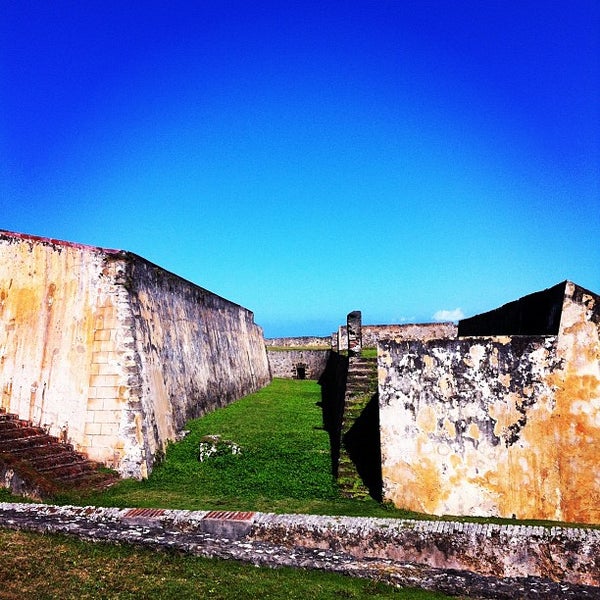 Here, at the highest points, more than 500 centimeters of precipitation falls annually.
Here, at the highest points, more than 500 centimeters of precipitation falls annually.
When preparing for a trip to the El Yunque National Forest, be sure to bring a raincoat and waterproof hiking boots, because it rains very often here and starts suddenly.
The El Yunque Rainforest is considered the crown jewel of the island. It is known as El Yunque due to its flat top. King Alfonso XII of Spain declared the area a protected nature reserve in 1876. In 1903, US President Theodore Roosevelt declared it the Luquillo Forest Reserve.
El Yunque is a hiker’s paradise with about 38 km of hiking trails. Routes vary in length, height and difficulty. Some popular excursions include the La Coca and Juan Diego trails, which lead to natural pools. The La Mina trail leads to the La Mina waterfall, where you can swim. The trail to Mount Britton offers breathtaking views from the 941 meter high mountain top and its observation tower. The Yokahu Observation Tower is open to the public, with an impressive panoramic view of the island at an altitude of 480 meters, for travelers by car, there is parking nearby.
While hiking in the jungle, take a guide who will orient you to local plant species and show you the rarest bird species including woodpeckers, mango gorgiverdes and the famous Puerto Rican parrot. If you’re looking for a more dizzying experience, strap on your seat belts to fly through the lush woodland at the Rainforest Zipline Park, or take in the jungle views while horseback riding along the banks of the Mameyes River on a tour of Carabali Park.
What makes El Yunque special
El Yunque not only belongs to the US Forest Service, but also boasts an incredible variety of flora, including 150 species of native ferns and 240 species of trees (23 of which grow only here) native to El. In addition, many small animals live in the forest, which are not found anywhere else on Earth. The coca tree frog, Puerto Rican parrot, and pygmy anode are among its endemic inhabitants.
How to get to
El Yunque
If you are coming from San Juan by car, take Route 3 out of town and after about an hour, take Route 191, which will lead you to the rainforest.
Tours are also available and can be arranged from hotels in the area. Companies offering rainforest tours include Acampa, Advnoentours, Countryside Tours, and Legends of Puerto Rico.
What to do in El Yunque
Most tourists travel through the forest on hiking trails of varying difficulty. The most visited is the La Mina trail, because it leads to the waterfall of the same name. This is the only waterfall in the jungle open for swimming. The only drawback of La Mina is that it is usually very crowded. In addition, there are no changing rooms, so take care of changing towels in advance.
When is the best time to visit El Yunque Rainforest
Since the temperature hardly changes, you can visit it at any time of the year. El Yunque is open every day from 7:30 am to 6:00 pm. Your admission ticket can be used to enter from 8:00 to 11:00 and from 12:00 to 15:00 daily. Recreation areas close at 17:30.
Nearby Restaurants
Don Pepe Restaurant
This fine restaurant offers all kinds of delicious Puerto Rican cuisine. If you have planned lunch, this place is located next to the road leading to the entrance to the forest.
If you have planned lunch, this place is located next to the road leading to the entrance to the forest.
Luquillo Stalls
A collection of small, family-run, beachfront eateries in nearby Luquillo serves a selection of Puerto Rican dishes, perfect for recuperating after a day of exploring El Yunque.
Tips for visiting El Yunque
Tropical torrential rains hit El Yunque almost daily, so bring raincoats or umbrellas and an extra set of dry clothes. Rains are short, but very strong. Hiking boots are also required as the hiking trails are quite slippery after rain. More importantly, if your visit is not part of an organized tour, be sure to plan ahead because, in the forest itself, cell and data services for most providers will be patchy at best.
What you need to know before you arrive
Puerto Rico measures 160 km by 56 km. Charm Island is home to almost 4 million people, with more than a million living in the San Juan metropolitan area. It is a multicultural, bilingual, modern and dynamic society influenced by Spaniards, Africans, Indians and Americans.
It is a multicultural, bilingual, modern and dynamic society influenced by Spaniards, Africans, Indians and Americans.
More from North America » Puerto Rico
6 Puerto Rico sites ready to tell the story of the island
From Masterweb
29.01.2020 16:42
The history of Puerto Rico is marked by the amazing achievements and determination of the people. Historical monuments, buildings and artifacts of the island speak of this, and if you are planning a trip to these places, these architectural monuments will help you learn about the cultural, political and economic past of the island.
Castillo San Felipe del Morro
In the ancient city of San Juan, which stands like an eternal guardian on a hill overlooking the Caribbean Sea, you will find the most famous historical landmark of Puerto Rico – Castillo San Felipe del Morro. This massive stone fortress was built by the Spanish colonizers to protect the island from incursions from the sea. Construction began in the 16th century, and most of the work was completed only by 1790 year. The fortress was completed and renovated in the 19th and 20th centuries.
This massive stone fortress was built by the Spanish colonizers to protect the island from incursions from the sea. Construction began in the 16th century, and most of the work was completed only by 1790 year. The fortress was completed and renovated in the 19th and 20th centuries.
The fortress is a testament to the fierce determination of the European settlers in Puerto Rico to defend their claims to new world settlements. The fortress is now listed as a UNESCO World Heritage Site and is open to the public both inside and out.
La Fortaleza
Built between 1533 and 1540 on a cliff overlooking San Juan Harbor, it is located just over half a mile south of Castillo San Felipe del Morro. The building originally functioned as a defensive outpost to defend against sea invaders. Since 1544, it has been used as a governor’s mansion, making it the oldest continuously occupied administrative residence in the entire Western Hemisphere.
Every weekday from 8:15 am to 3:30 pm, Hotel La Fortaleza organizes 30-minute walking tours of the interior and exterior areas.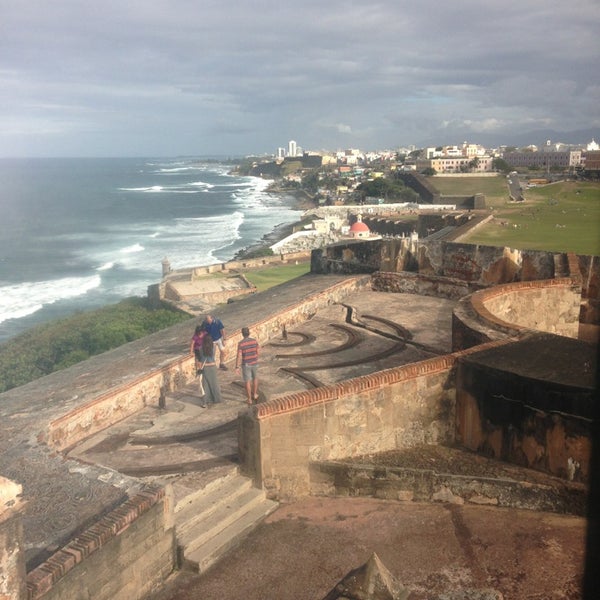 When you need to fill up, there are tons of great restaurants in this part of town.
When you need to fill up, there are tons of great restaurants in this part of town.
Castillo San Cristóbal
In response to the ongoing threat of invasion, the Spanish colonial authorities built another formidable fortress east of La Fortaleza. Work on the Castillo San Cristobal began in 1634 and was finally completed in the late 1700s. The building is considered the largest Spanish fortification built in the New World.
The Castillo San Cristobal has three separate levels and you can explore its interior through a series of tunnels that weave in and out of the complex. The fortress has been meticulously preserved and restored, and its vast outer area is popular with kite-flyers and picnickers.
Like other grand fortifications of the capital, Castillo San Cristobal was included in the list of UNESCO World Heritage Sites. You can visit all three described fortresses in one day on foot, exploring Old San Juan.
Museo Castillo Serrallès
Built on a hill overlooking the city of Ponce by a wealthy rum baron family in the 1930s, the impressive Castillo Serrallès Castle has been converted into a museum and architectural landmark open all year round for visitors.
The former home of the Serralles family, designed by local architect Pedro Adolfo de Castro y Besos, is an example of the Spanish Renaissance style popular in the early 20th century.
The mansion has spacious, luxurious rooms and reception areas, meticulously manicured grounds with sprawling green lawns and huge terraced gardens. While a tour of the hotel itself is likely to be the highlight of your visit, you’ll also get fascinating details about the history of Puerto Rican sugar cane production and rum production.
El Museo Castillo Serrallès is located in Ponce, on the south coast of the island. From San Juan, take Highway 52 and you’ll reach your destination in less than two hours.
Hacienda La Esperanza
Sugarcane production has been the dominant industry in Puerto Rico for over four centuries. Visiting Hacienda La Esperanza in Manati, you can take a step back in time to immerse yourself in a bygone era.
This 800 ha estate was a fully functioning sugar plantation in the 19th century. The hacienda, which at the time was the home of a wealthy planter, has been painstakingly restored to give visitors an idea of how the sugar cane was grown, harvested and processed. Slave labor has been used on plantations such as this since the 19th century and is an integral part of the island’s past. It is important to remember these dark moments of history in order to prevent their repetition in the future.
The hacienda, which at the time was the home of a wealthy planter, has been painstakingly restored to give visitors an idea of how the sugar cane was grown, harvested and processed. Slave labor has been used on plantations such as this since the 19th century and is an integral part of the island’s past. It is important to remember these dark moments of history in order to prevent their repetition in the future.
The hacienda has since become the largest natural reserve in northern Puerto Rico. Here is a unique nature: mangrove forests and swamps, in which life is in full swing. The hacienda serves as a tourist center and museum. You will find it about 60 km west of San Juan and it takes less than an hour if you drive along Highway 2 or 22.
Caribe Hilton Hotel
Strange as it may sound, the Caribe Hilton hotel played a role in the development San Juan and became part of the history of Puerto Rico.
December 9, 2019 marks the 70th anniversary of the opening of the Caribe Hilton in San Juan.
 These tunnels protected soldiers from enemy fire and allowed the safe movement of troops, weapons and supplies. This enabled the defenders to engage the enemy before they reached the city gate if attacked by land. Gunpowder could be placed in other tunnels, called “countermines” to explode beneath the feet of an attacking enemy. Countermining tunnels served to destroy parts of the battlefield and also had the potential to block enemy access to the fortress through them.
These tunnels protected soldiers from enemy fire and allowed the safe movement of troops, weapons and supplies. This enabled the defenders to engage the enemy before they reached the city gate if attacked by land. Gunpowder could be placed in other tunnels, called “countermines” to explode beneath the feet of an attacking enemy. Countermining tunnels served to destroy parts of the battlefield and also had the potential to block enemy access to the fortress through them. Artillery ramps provided access to the main firing battery and the dry moat.
Artillery ramps provided access to the main firing battery and the dry moat. The theater located in the visitor center shows a movie in English and Spanish about the history of the park.
The theater located in the visitor center shows a movie in English and Spanish about the history of the park. Floyen
Floyen